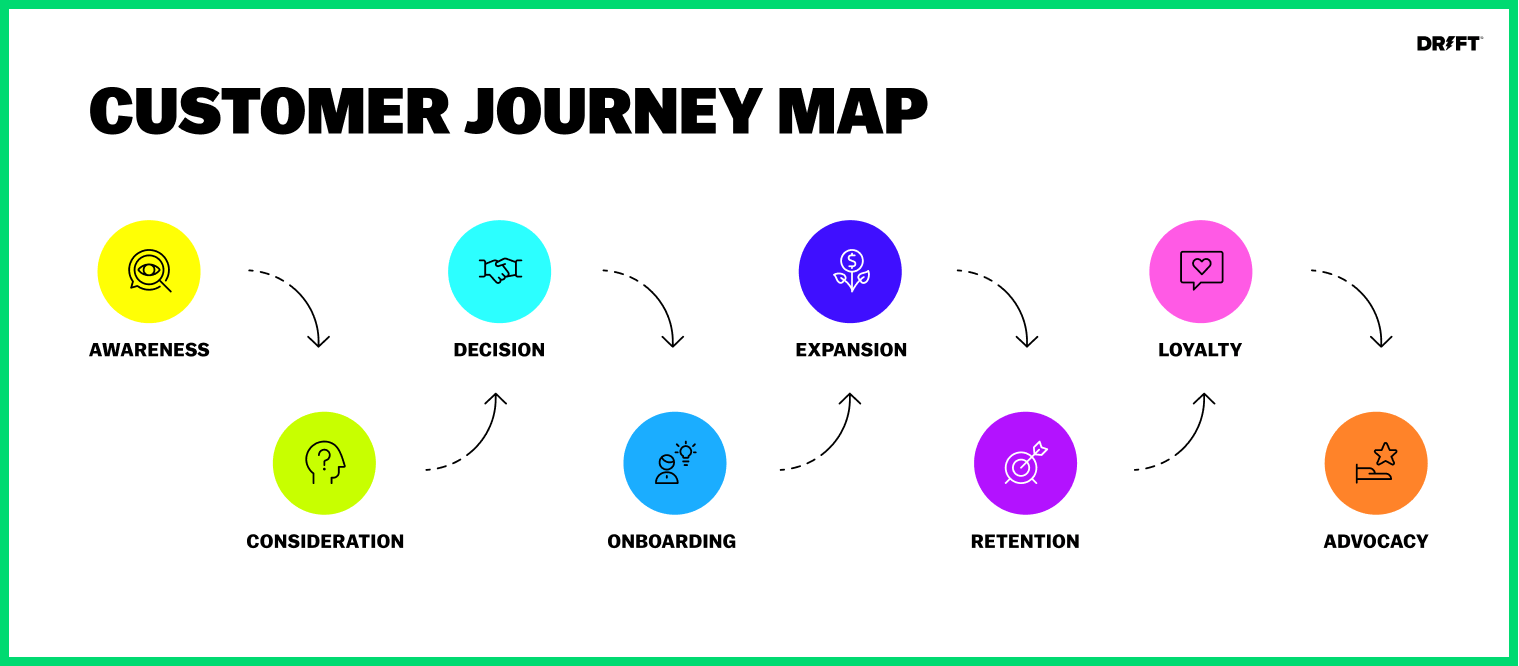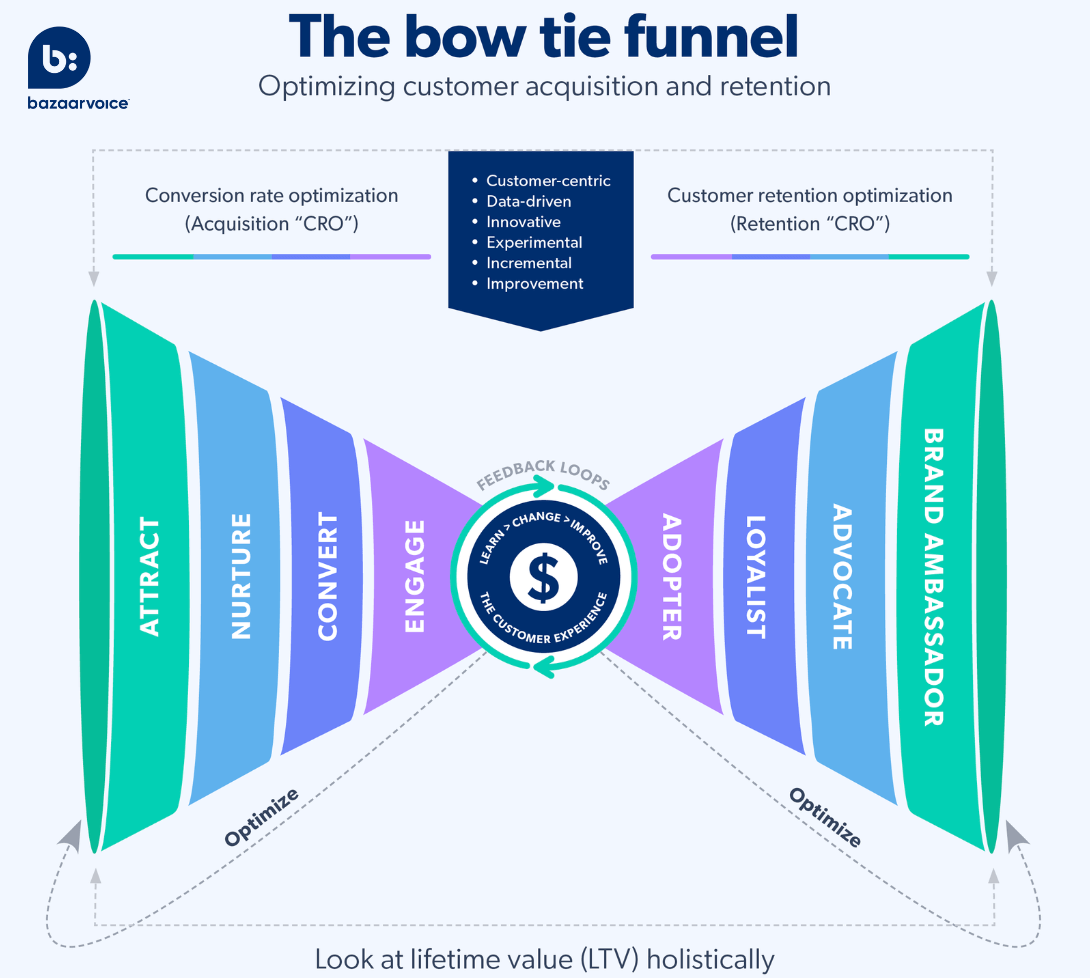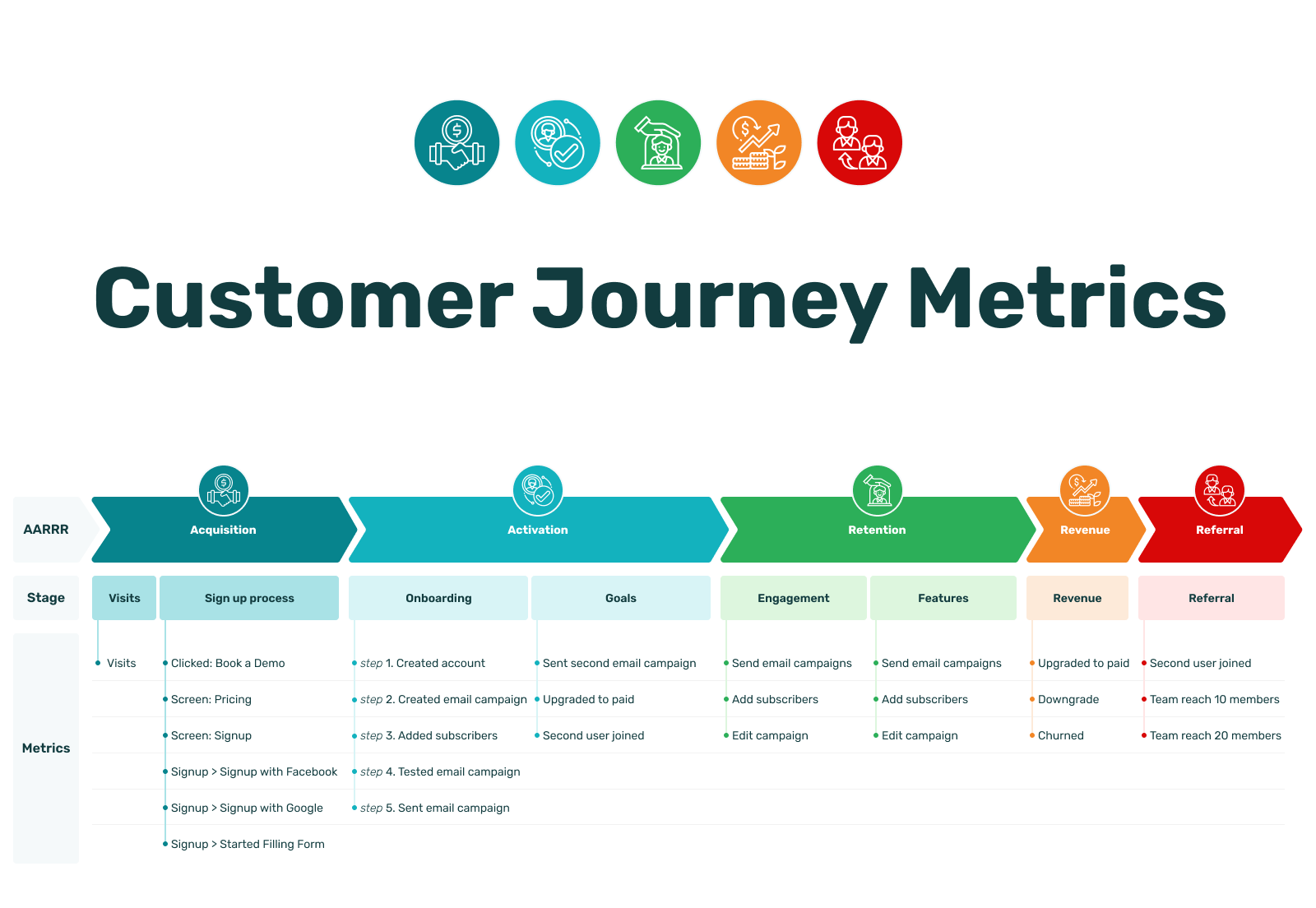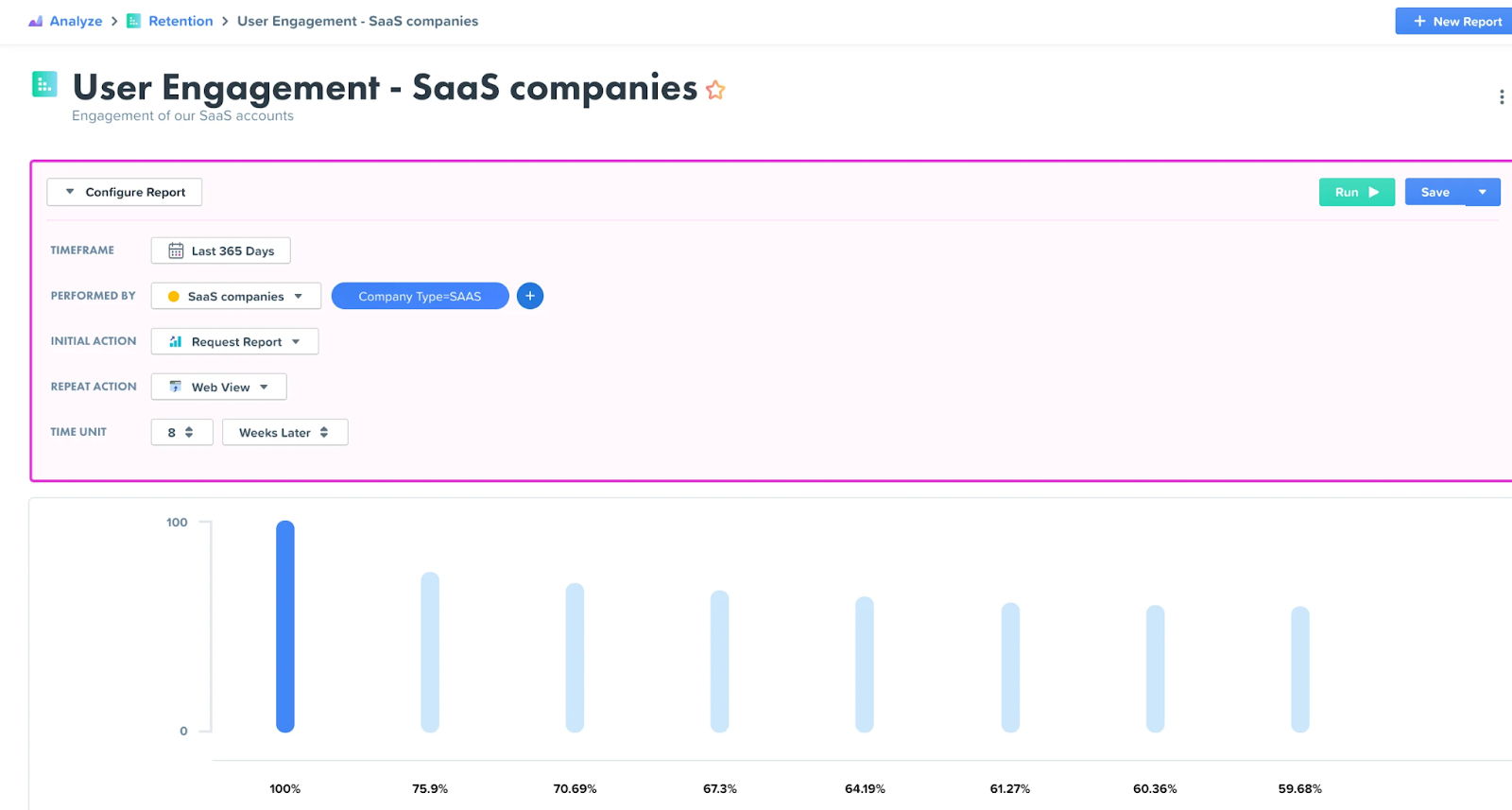Every impression and interaction ties together, forming a customer’s unique journey with a brand. This path goes from initial awareness to the critical purchase moment, and further, to post-purchase happiness. Knowing the journey's value is key to better customer engagement and satisfaction.
Creating a better customer journey requires looking back while planning for the future. It's more than just meeting needs; it's exceeding them wherever possible.
Every touchpoint should not only hit the mark but also strengthen the bond between brand and customer. We’ll dive into how it works.
Understanding the Basics of the Customer Journey
Creating a seamless customer journey starts with knowing every customer interaction with your brand. This covers everything from the first moment of interest to thoughts after buying. Each point of contact shapes customer expectations and affects their next steps.
 Source: Drift
Source: Drift
To understand these touchpoints better, a journey map is key. This tool helps visualize the customer’s story. It shows the high points and the stumbling blocks in their experience.
A good journey mapping tool helps businesses, old and new, learn from these maps. By continuously improving this method, your company stays in tune with changing customer needs. This way, you create a journey that matches what customers hope to experience.
- Spot crucial times when you can greatly satisfy customers or disappoint them.
- Check if what you're doing now works well and make needed changes.
- Try to meet and beat what customers expect, creating loyal supporters of your brand.
A journey map should be updated often because it reflects changing customer likes and dislikes. Keeping the map fresh ensures it accurately shows the customer journey. This keeps your approach focused on the customer above everything else.
Dissecting the Customer Journey Map and Its Significance
Imagine embarking on a crucial mission to boost your brand's connection with your audience. You will need a customer journey map. This map captures every interaction your customer has with your brand.

It's not just a visual aid; it's a tool to improve customer experience, making every interaction count towards satisfaction.
The customer journey map shows how customers interact with your brand, based on a well-researched customer persona. As you understand each persona's needs, you can tailor each touchpoint effectively.
This approach, grounded in understanding your customers, makes their experience with your brand unforgettable.
- Analyze key customer touchpoints: From the first digital ad they see to the follow-up call after purchase, these points build loyalty.
- Gauge the emotional landscape: Every touchpoint can trigger emotions. Understanding and optimizing these reactions is key.
- Iterate to innovate: Use feedback to improve touchpoints, making the customer journey better over time.
No matter if you're just starting or running a big company, managing customer experience is key. A customer journey map is never fixed; it evolves with your customers' needs. Focus on this essential part of marketing. It helps you succeed with data and a real desire to enhance customer experience.
Why the Customer Journey Can Make or Break Your Business
Understanding the customer journey is crucial for businesses wanting to succeed today. Every interaction shapes how customers see your brand and decide to stay loyal. Great customer service is key, guiding them towards making purchases and staying connected to your brand.
 Source: The Bazaar Voice
Source: The Bazaar Voice
You'll face key moments where your brand's promise is tested. These moments can turn customer satisfaction into delight, building strong relationships through customer satisfaction.
- Superior Customer Experience: Integrating experience management into your strategy makes your journey stand out. It creates a story that shows your commitment to meeting users' needs.
- Conversion Rate Boosts: Making it easier for customers to move through touchpoints increases your chances of making sales. This smooth transition can enhance loyalty and drive up conversion rates.
- Post-Purchase Crucible: What happens after a sale is just as important as what happens before it. Excellence after the purchase turns buyers into brand advocates for life.
- Invaluable Customer Delight: Offering personalized experiences and positive interactions sparks delight. This shows your brand understands and exceeds customer expectations.
Mapping your customer journey involves outlining each stage and adding meaningful moments. This approach, through customer service and experience management, boosts customer retention and customer satisfaction. In short, the customer journey is more than a strategy. It's the core of what can drive your business to success or failure.
The Customer Journey in the Digital Age
The digital world has changed how we experience and manage customer journeys. Customer data platforms play a key role in collecting and merging data from various sources. They give a complete picture of the customer. This ensures that every part of the digital customer experience fits together well.

Adding customer journey management to your digital plan is crucial. Companies like Amazon and Uber have shown how detailed journey planning profoundly affects business. They teach us that being quick, smooth, and building real connections with customers are key today.
Digital technology helps us connect more deeply with our customers. Let's explore the ways it does this:
- Personification at Scale: Advanced customer data platforms let you tailor digital interactions uniquely. This way, you reach each customer in a meaningful way, even in a large crowd.
- Real-Time Insights: With customer journey analytics, you know what your customers go through in real time. This knowledge lets you act fast to improve their experiences.
- Omnipresent Engagement: Every digital point of contact is an opportunity to enhance the customer journey. It's vital to create cohesive experiences across mobile, desktop, or smart devices.
- Empowered Employees: Providing your team with the latest tools supported by a strong customer data platform leads to better decisions, quicker support, and happier customers.
Use customer journey analytics to better understand customers' digital paths and expectations. This insight is crucial for refining touchpoints and offering unmatched value.
In today's digital era, connecting with customers must be both tech-savvy and focused on human needs. By using customer data platforms, analytics, and empathetic planning, the digital experiences you create now will earn customer loyalty for the future.
Essential Metrics to Evaluate in the Customer Journey
To optimize your brand's customer journey, it's key to focus on crucial metrics. These reveal insights at every customer touchpoint. By using customer feedback and studying these metrics, you can refine your approach.
 Source: InnerTrends
Source: InnerTrends
This improves engagement and satisfaction. A journey map template helps structure and analyze the data well.
- Conversion Rate: How many prospects are turning into customers?
- Call Abandonment Rate: Are customers hanging up before speaking to an agent?
- First-Contact Resolution: Are customer issues resolved on the first call?
- Average Handle Time (AHT): How long does it take to handle a customer interaction?
- Customer Effort Score (CES): How easy is it for customers to interact with your company?
Operational metrics give quick insights into customer interactions. But, it's also important to look at overall data. This shows the health of customer relationships over time.
- Customer Satisfaction (CSAT): Are your customers happy with their experiences?
- Net Promoter Score (NPS): Would your customers recommend your brand to others?
- Customer Lifetime Value (CLV): What is the financial value of a customer over time?
- Average Customer Retention Rate: How well do you retain customers?
Adding these metrics to your assessment loop offers important insights. It leads to big improvements in the customer journey. Remember, tracking, understanding, and acting on this data changes good experiences into great ones.
Creating a More Human Customer Experience with Technology
The digital age brings new chances for companies to use customer data and better their service. Yet, it's crucial to create experiences that feel personal in this tech-forward time. Finding the right balance is key.

This means improving employee experiences and using new tech for customer support while keeping a personal touch with customers.
When adding a top-notch help center or diving into customer data, aim to boost not just support speed and efficiency. You should also increase empathy and understanding. See technology as a way to make customer experiences more connected and customized, not as a block to personal touch.
- Experience Management: Implementing tools to track and analyze customer interactions ensures that every touchpoint is informed by previous engagements, personalizing the experience.
- Employee Experience: Ensure that your team has access to the right technology which empowers them to deliver exceptional service, which in turn, reflects in customer satisfaction.
- Customer Data: Utilizing robust analytics to understand customer preferences and behaviors allows for a more attentive and responsive service that anticipates customer needs.
- Customer Support: Leveraging technology to streamline processes and provide quick resolutions enhances the overall quality of support offered to customers.
- Help Center: Developing a resource-rich help center supported by technology enables customers to find solutions effectively, often through self-service options that are available 24/7.
To mix technology with a human touch well, focus on features and tools that solve issues and also make customers happy. This way, you'll fix the 'experience disconnect' and use your tech investments fully to offer a customer experience that's caring, deliberate, and very human.
The Key Phases of the Customer Journey
Understanding the entire customer journey is key when dealing with customers. It includes critical stages such as awareness, consideration, purchase, retention, and advocacy. Each phase is crucial for cultivating customer loyalty and maps out the path to lasting business success.
- Awareness: This is where customers first learn about your brand. Through search engines or social media, they come across your marketing efforts.
- Consideration: Now aware, customers evaluate what you offer. They compare you with others and closely examine your products to see if they meet their needs.
- Purchase: This phase is where customers decide to buy. Making this process smooth can solidify their decision to commit to your brand.
- Retention: Keeping the customer happy after purchase is your goal now. Excellent service and support at this stage ensure they keep coming back.
- Advocacy: Satisfied customers turn into brand advocates. They share their great experiences and recommend your brand, becoming a powerful marketing asset.
Successfully moving through these stages needs a deep commitment to excellent experiences at every turn. Done right, this journey not only meets but exceeds customer expectations, fostering a strong cycle of loyalty and business growth.
Integrated Data: The Backbone of a Comprehensive Customer Journey
In our digital world, customer data is super important. It helps us understand customer behavior. When you use mapping tools, this data brings your customer's journey to life. It shows what your customers really care about.
Think about using a journey map template that shows not just what customers do but also how they feel. This helps you see things from their perspective. Using tools like Google Analytics, you can find out what works. This helps turn people who just look into loyal customers.
- Utilize integrated customer data to identify patterns and personal preferences.
- Enhance your journey map template by overlaying quantitative data with qualitative insights.
- Employ a mapping tool to reveal and rectify gaps in the customer journey.
- Leverage Google Analytics to monitor and optimize customer behavior across all touchpoints.
When you get good at using these tools, you lead in creating great customer experiences. Remember, you have the control to shape this journey. Using integrated data is your secret to success.
Improving the Entire Customer Journey with Woopra's Analytics Software
Today's business world is very competitive. It's crucial to understand and improve how your customers experience your service. Woopra's analytics tool is key for this. It provides detailed customer journey analytics to delve into each step of a customer's experience. With Woopra, you can closely examine and improve every phase to meet customer expectations and needs.
Imagine being able to analyze every customer interaction easily. That's what Woopra offers. It tracks all interactions, evaluates how well you're engaging customers, and finds points that can be better. This data helps you fine-tune your approach, making the journey more personal and effective for your audience.
- Analyze customer behavior to understand the 'why' behind every action.
- Utilize product analytics to fine-tune your offerings and boost appeal.
- Employ dynamic customer journey map examples as blueprints for success.
- Measure impact with defined metrics, turning data into actionable strategies.
With Woopra's visuals, leaders can create experiences that go beyond meeting customer expectations. The focus shifts towards building loyalty and turning happy customers into vocal advocates. Start changing your customer's journey now. See how these efforts lead to growth and success for your brand.
Best Practices: Bringing It All Together for an Enhanced Customer Journey
Refining the customer journey is like mastering a complex symphony. Every note must harmonize. Each team member plays a crucial role. It starts with understanding your buyer's needs at every stage of their journey. This ensures you meet their desires without missing a beat.
What really makes a difference is combining data with a human touch. By making customer interaction smooth and using technology as a supportive tool, you create a bond. Each interaction should feel like a personal concert, showcasing your focus on their needs. This builds loyalty and turns casual buyers into devoted fans.
To succeed, measure your actions carefully and always look to improve. By tracking the right metrics, you can adjust your strategies for better outcomes. Your goal is to earn applause from your customers, encouraging them to return and recommend you. Reflect on your readiness and audience anticipation. A standout customer journey can lead to a standing ovation for your brand.


